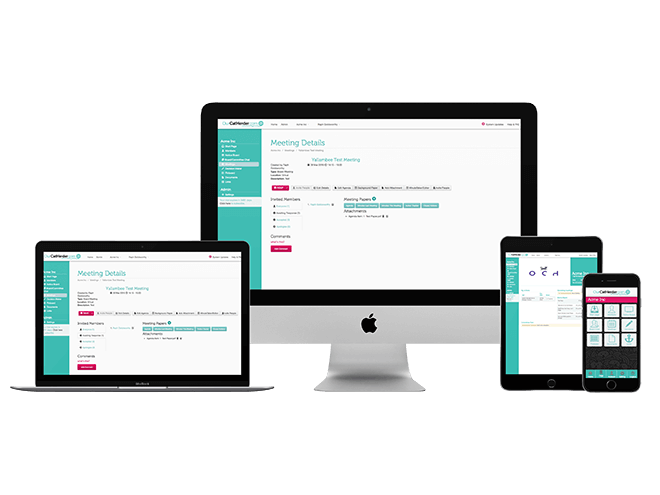non-profit-fact-sheets
What is a board portal?
Published: April 3, 2023
Read Time: 8 minutes
A board portal is a secure piece of software, utilised by an organisation’s boards of directors, advisory board, committees, subcommittees, board task forces and their respective members or directors, to manage the ‘business’ of the board. Board portals offer a range of features that can vary depending on the vendor providing the portal service, that allow directors, executives, senior leadership teams, and others organisational leaders who report to the board to interact with and support its work. A board portal also facilitates the sharing of information and efficient collaboration between people.
Why is board portal use increasing?
Usage of board portal software by Australian not-for-profit and for-purpose boards has been rapidly increasing in the past few years for a variety of reasons. The trend is global and extends to various types of companies and industries. This is due to a rise in Software As A Service (SAAS) models, an increase in digitally savvy professionals joining boards, a bigger workload, the desire to streamline internal processes and better manage risks, and a need to save time and money.
The rise of Software As A Service (SAAS)
The rise of SAAS models (also known as cloud software) is helping to make software such as board portals far more affordable. In the past, for a board to have a portal the organisation would have needed its own internal information technology team to build and maintain a customised system. Maintaining a custom board portal is an expensive proposition for any organisation. However, solutions such Amazon Web Services have reduced the cost of on-demand computing power , and significantly increased accessibility. As well, the rise of smartphones and tablets means vendors can offer board portal software to many organisations at a lower cost and in a more accessible way.
More digital native directors joining boards
An increase in the number of technology-literate organisational leaders, particularly as digital native generations begin to join boards, is driving the widespread adoption of board portals by many types of organisations. As ‘digital native’ directors join boards, they expect to be able to use the software as a tool to perform tasks in the same manner that they would in their work and other parts of their life. In fact, for many established boards who would like to recruit younger directors or those with strong technology backgrounds, not having a board portal sends a strong signal that the organisation is not ready to embrace change.
Directors are as busy as ever
Between work, friends, family and often multiple directorships, board directors increasingly have less time to put toward an ever expanding workload. This, of course, can be exacerbated by having to deal with an organisation with major problems to be sorted out or significant strategic challenges to overcome. Hence, directors are seeking out ways to improve the efficiency of ‘board business’. Board portals are an increasingly popular solution. They allow those who support the board to be more effective in the preparation of papers and packs. They also help individual directors to improve their efficiency in performing board related tasks, giving them access to information and documents when and where they need them. Portals reduce the delay of having to request documents or having them couriered by post. Additionally, board portals help improve the running of board meetings and the general dissemination of other critical information to which directors may require access.
Streamlining boardroom processes
A board portal has the benefit of increasing productivity and streamlining organisational processes. As a tool, portal software can create a clear trail of documented decisions and actions, helping board members stay informed at every step and refer to past discussions easily. A portal is meant to streamline meeting management, facilitate communication between board members and others at every step, and assist in storing and organising important documents. Board portals also make governance processes go more smoothly, empowering directors to focus on important issues such as mitigating risk, managing a crisis, and ensuring compliance issues are met. This can have the added benefit of keeping board members engaged and interested in the work they do and makes organisational oversight simple and efficient.
Managing risks
Board software can help your organisation manage risks such as privacy breaches by organising files and documents and controlling who has access to them and who doesn’t. The portal can help keep sensitive and confidential information separate and secure, allowing directors to meet legal obligations such as protecting privacy. Organisations and companies must meet certain legal requirements to maintain their legal status. Compliance can be enhanced by using a board portal and reducing the chances of failing to collect and track important data needed to create reports. Documenting decisions and actions is also key to having trust and credibility with shareholders. A board portal can make this process easier and help directors share access to important reports and data when requested.
Saving time and money
It costs money to run any board. And who doesn’t want to save dollars? In the not-for-profit sector, there is no shortage of situations where a few dollars saved in one place, can be immediately deployed in another. When board portal software is put in place, organisations can often trim significant board related costs and allocate the money elsewhere. So, while there may be an initial cost for implementing the portal, this is offset by the savings made in areas such as staff wages for preparing and distributing meeting packs, minutes, and reports. Board portals also eliminate the costs associated with printing and mailing out documents needed to conduct meetings and board business. The amount of time that must be spent on preparing for a board meeting is usually very significant, days for some boards! But with most board portals this can be cut down to just a few hours.
What features should a Board Portal have?
Board portals offer a range of features that allow directors, executives, senior leadership teams, and others who report to the board to interact with or support the work of the board, to share information and efficiently collaborate with each other. These features include 1) easy-to-use turnkey solutions that anyone with basic computer knowledge can use or access with limited IT support; 2) easily searchable and up-to-date information your board has created and uploaded; 3) an option for board members to communicate with each other between meetings to enhance collaboration; and 4) access to training materials such as documents related to governance and other legal issues.
What should I look for in a Board Portal?
The single most important feature in a board portal is ease of use which leads to the portal being easy for the board to adopt quickly. Ease of use is especially beneficial when a change in board membership occurs, or directors take on a new role. If the portal is not easy to use, then directors will have difficulty finding the information they need to conduct board business. In this case, the money spent on introducing a new board portal software system will have been wasted. It’s important to choose a portal software that can make getting started as a new board member a smooth process. The less training board administrators and directors need, the more likely they are to use the portal properly and get the job done.
What is board management software?
Board management software, also known as a board portal, is a specialised type of software designed to improve the governance of an organisation. It helps governance professionals to streamline processes such as minute taking, collaboration, taking notes, and tracking actions and decisions. It can also help ensure governance best practices are followed. Board management software is meant to simplify your board’s activities by providing directors with a centralised secure platform where they can vote, communicate, collaborate, and access important materials.
What is a board pack?
Board portals like Our Cat Herder provide board pack creation functionality. A board pack is the collection of documents for a board meeting, formatted into a structured pack for each board member to read prior to the meeting. A board pack will include a variety of documents. The most common documents included are - the meeting agenda, background papers relating to discussion points and decisions, outstanding actions and any other documents relevant to the meeting.
Are board portals secure?
Board portals are secure and aim to keep sensitive and confidential data protected. In fact, this is one of the main advantages to having board portal software compared to DIY portals or manual board processes. The risk of losing a device or downloading information on public Wi-Fi is much lower when you use a portal. Most portal software will offer security measures such as two-factor authentication or single sign-on features, role-based access, and usage reports to identify any irregular activity.
Additional Resources
Share this Article
Recommended Reading
Recommended Viewing
Author
- About
-
Better Boards connects the leaders of Australasian non-profit organisations to the knowledge and networks necessary to grow and develop their leadership skills and build a strong governance framework for their organisation.
Found this article useful or informative?
Join 5,000+ not-for-profit & for-purpose directors receiving the latest insights on governance and leadership.
Receive a free e-book on improving your board decisions when you subscribe.
Unsubscribe anytime. We care about your privacy - read our Privacy Policy .











